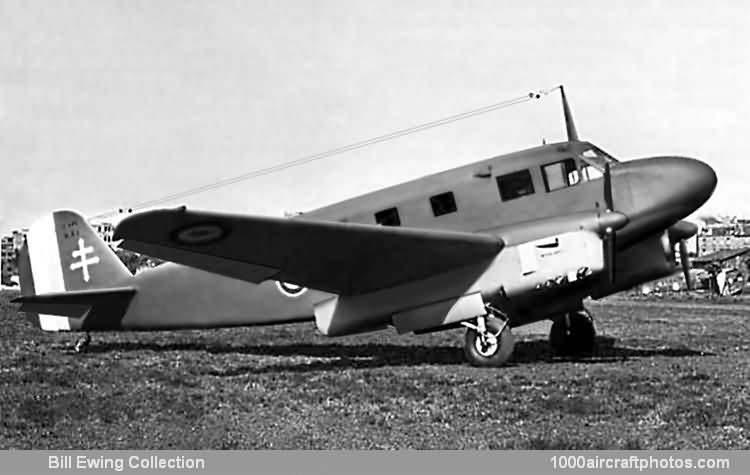The two-spar wing was of spruce and plywood with a plywood skin, and inboard of the inset ailerons the whole trailing edge of the wing was occupied by flaps which also extended beneath the fuselage. The fuselage was largely of wood and had plywood skinning except for the nose section and upper decking which had stressed sheet metal covering. The cantilever tail unit was also a wooden structure, its fixed surfaces plywood-covered and control surfaces fabric covered.
Streamlined nacelles for the 180 hp Renault Bengali-Six engines extended below and to the rear of the wings; and the main landing gear units, each incorporating an oleo-sprung fork, retracted rearwards to lie wholly enclosed within the engine nacelles. The prototype had fairings attached to the front of each main leg to cover the wheel wells when the landing gear was retracted, but the next two C.440s had two wheel well doors attached to the underside of each nacelle, a feature of all future Goélands. A non-retracting steerable tail wheel was fitted.
In its basic passenger configuration the Goéland had comfortable cabin accommodation for six passengers. The pilot and co-pilot, who doubled as wireless operator, were seated side-by-side and had dual controls. Baggage holds were located fore and aft, and a toilet was situated at the rear of the cabin.
The Goéland remained in production in several versions up to WW II, the principal model being the C.445, also adopted by the Armee de l'Air as the C.445M and used for a variety of tasks, including military communications duties and crew training. Some C.445Ms were used by the Aeronavale. Civil users of the Goéland included Air France, Air Bleu and Regie Air Afrique. Air Bleu used one C.444 and several C.445s on night mail routes from Paris to the Spanish border, and Regie Air Afrique operated the type on its North African routes. Other Goélands flew passenger services in French West Africa and Madagascar. The type was sold abroad to Aeroput of Yugoslavia, and to Bulgaria and Spain. Two C.445Ms were supplied to the Belgian Aéronautique Militaire in 1940.
Production continued during WW II, and after the German occupation of France 44 C.445s and 10 C.445Ms were requisitioned, some flying on Lufthansa routes and others being operated by the Luftwaffe. Considerable numbers of the C.445M and C.449 were built for the Germans at Renault's Billancourt and Caudron's Issy-les-Mou-lineaux factories. Production at Billancourt, however, was reduced to a trickle after a heavy RAF raid in 1943.
The Germans used the Goéland as a pilot, radio and navigational trainer, for communications, and a small number had glazed noses for bomb-aimer training. In addition to the C.447 specialized ambulance version with accommodation for four litters, a few other Goélands were used for casualty transport. Other Goélands served the French Vichy regime, while a number were scattered throughout France's overseas empire, most of them in North Africa. Several C.445s operated in the UK after June 1940.
In 1945 the Caudron plant was taken over by the French government as the Ateliers Aéronautiques d'lssy-les-Mouli-neaux. Here production of the C.445M and C.449 continued under the designation AA.1. Post-war Goélands continued in service with Air France. At the beginning of 1946 the company had 23 C.445s and 19 C.449s at its disposal; these flew domestic night mail services for a time, but were employed for many years as crew trainers. Other civil operators included SABENA and two French companies, Aigle Azur and CAT (Compagnie Air Transport). Goélands continued to fly for a number of years on a wide range of duties with the Armee de l'Air.
Production of all versions of the Goéland totaled 1,702. A number of early aircraft were converted subsequently to later versions. The production listing below totals 1,446; it has not been possible to verify the sub-type designations of the remaining 256 Goélands. From the C.441 on, the aircraft were fitted with two 220 hp Renault 6Q engines (from C.444 on with contra-rotating propellers), with the exception of the C.446 (450 hp Renault 12-R), and the C.448 and C.449 (both types 240 hp Renault 6Q).
C.440: Prototypes (3)
C.441: Dihedral added to outer wing panels (4)
C.444: First version with contra-rotating propellers (17)
C.445: C.444 with dihedral of outer wing panels increased (114)
C.445/1: (2)
C.445/2: (3)
C.445/3: Postwar production version (510)
C.445M: Militarised version (404)
C.445R: Long-range version (1)
C.446 Super Goéland: (1)
C.447: Air ambulance version (31)
C.448: Supercharged engines (7)
C.449: Final production version (349)."
The following data relate to the C.445M.
